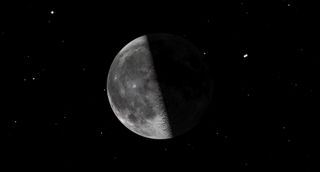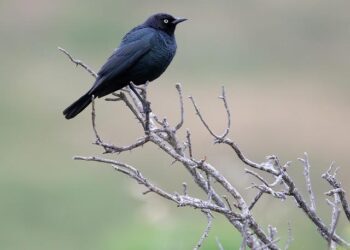Home
News
Skywatching

An illustration of the third-quarter moon on July 09, 2023.
(Image credit: Starry Night Software)
July’s last quarter moon will set by midday on Sunday (July 9), so plan accordingly to see it late tonight.
The moon will be in its half-lit third-quarter phase when it rises from the eastern horizon shortly after midnight overnight tonight before setting to the west around 1 p.m. ET (1700 GMT) on Sunday (July 9), according to In-The-Sky.org. During this phase, which gets its name from the fact that it falls three-quarters of the way through the moon’s 29.5-day lunar cycle, the moon will be illuminated on its western, sunward side.
The best time to view the third-quarter moon will be around the time it’s at its highest in the sky, between around 5 a.m. and 7 a.m. ET (0900 and 1100 GMT). While many features of the lunar landscape can be viewed during the daylight hours, make sure to take precautions not to point any optics in the direction of the sun if you attempt a daytime observation of the moon, which could cause vision damage.
Related: Night sky, July 2023: What you can see tonight [maps]
The third-quarter moon is positioned in the sky ahead of Earth in terms of its yearly trip around the sun. Earth follows behind the moon by about 3.5 hours.
Following the third-quarter moon, skywatchers can look forward to increasingly less illumination coming from our natural satellite going into July’s new moon, which occurs on July 17. The dark skies in the days following the third-quarter moon and approaching the new moon make for an excellent opportunity to look for deep-sky targets such as the relatively newfound comet C/2023 E1 (ATLAS).
After the third-quarter moon has set early this afternoon, C/2023 E1 (ATLAS) will be positioned in the northern skies just below the handle of the “Little Dipper,” the Ursa Minor constellation.
If you are hoping to catch an up-close look at the moon at any point throughout its 29.5-day lunar cycle, our guides to the best telescopes and best binoculars are a great place to start.
And if you want to take photos of the moon or the night sky in general, check out our guides on how to photograph the moon or the best cameras for astrophotography and best lenses for astrophotography.
Editor’s Note: If you get a great picture of the third quarter moon and would like to share it with Space.com’s readers, send your photo(s), comments, and your name and location to [email protected].
Join our Space Forums to keep talking space on the latest missions, night sky and more! And if you have a news tip, correction or comment, let us know at: [email protected].
Breaking space news, the latest updates on rocket launches, skywatching events and more!
Brett is a science and technology journalist who is curious about emerging concepts in spaceflight and aerospace, alternative launch concepts, anti-satellite technologies, and uncrewed systems. Brett’s work has appeared on The War Zone at TheDrive.com, Popular Science, the History Channel, Science Discovery, and more. Brett has English degrees from Clemson University and the University of North Carolina at Charlotte. In his free time, Brett is a working musician, a hobbyist electronics engineer and cosplayer, an avid LEGO fan, and enjoys hiking and camping throughout the Appalachian Mountains with his wife and two children.
>>> Read full article>>>
Copyright for syndicated content belongs to the linked Source : Space.com – https://www.space.com/half-lit-moon-third-quarter-july-2023































